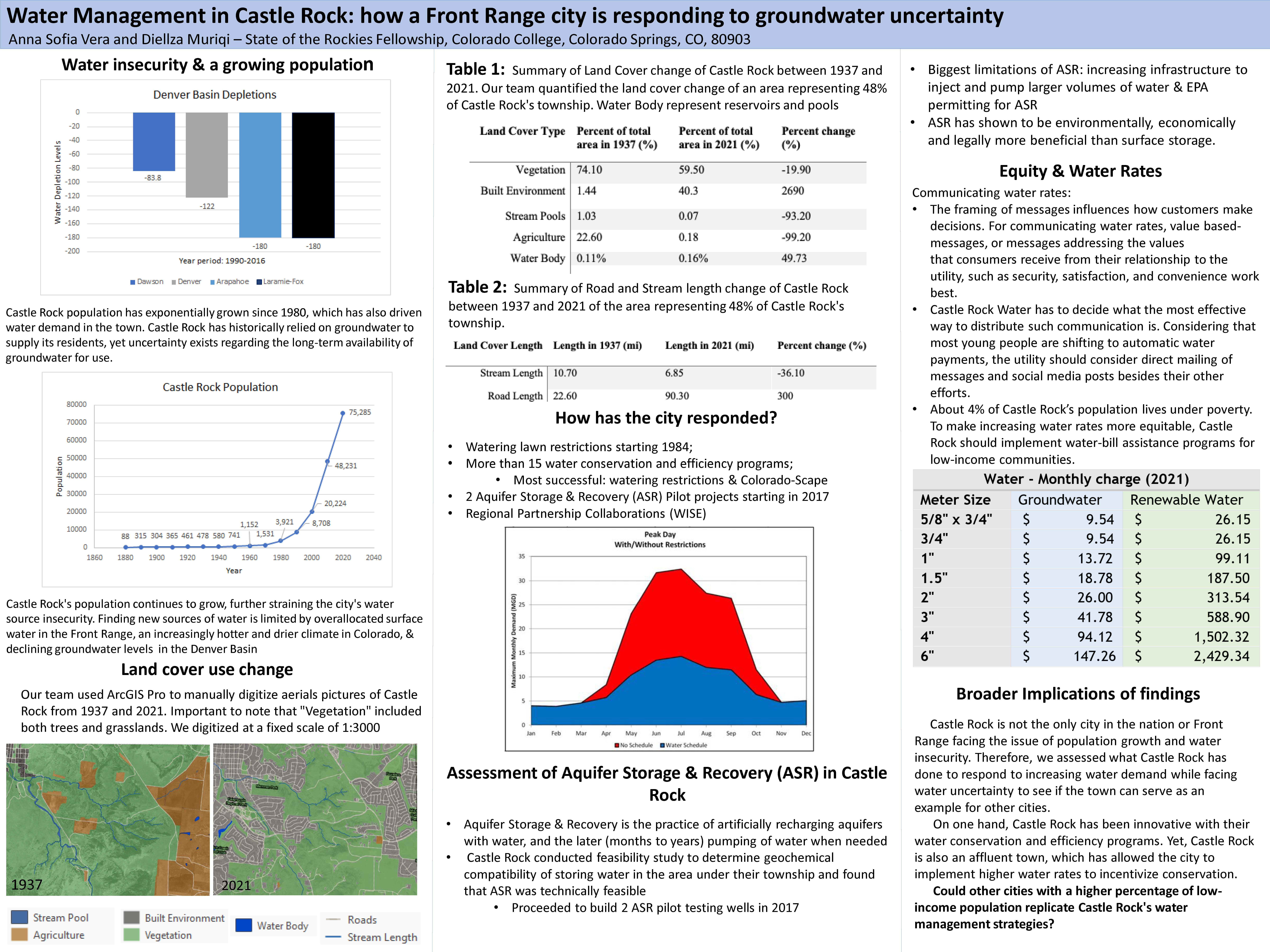Castle Rock Water Management
Castle Rock, Colorado is one of the fastest-growing cities in the country and has been for two decades. The city’s area continues to expand to accommodate the increasing population in spite of the growing cost of building and utilities. Supplying water to the town’s residents has been a challenge since Castle Rock's founding in the 1870s. Relying on limited surface flow and a confined aquifer, the town continues to boom as the scarcity of water supply in this geographic location rapidly increases.
Project Overview
Anna Vera, '22, and Diellza Muriqi, '22 work their way through heaps of historical materials provided by Douglas County Archivist Joan Gandy. 6/2021
The future of water supply in Castle Rock, Colorado, a rapidly expanding Rocky Mountain Front Range city
What is the future of the water supply in Castle Rock, Colorado? How are officials and residents in this Colorado Front Range town responding to the growing water demands and a changing climate? What are their plans for a sustainable future? Does the plan consider equally all segments of the town’s population?
This summer, two Rockies summer interns documented the spatiotemporal changes the town of Castle Rock has undergone since 1937. A GIS analysis demonstrates significant changes in land use cover as expected with population increase. To provide an accurate historical account, the interns worked closely with the county’s archivist to help tell the story of the town's evolution and its ongoing water crisis.
The students interviewed Castle Rock, Douglas County, and state officials about the town’s current conservation programs and plans for the future. We looked for broader implications in our findings by asking whether the sustainability approach implemented by the town of Castle Rock could serve as a model for other cities in geographically semi-arid environments.
We are sharing our research findings and implications with Castle Rock town officials, Douglas County Library, conservation advocacy groups, economists, the campus community, and others by featuring this work in State of the Rockies publications, web posts, social media platforms, and other campus communications venues and media.
— Cyndy Hines, State of the Rockies Project Specialist
Abstract
Water management in Castle Rock, Colorado: how a Front Range city is responding to groundwater uncertaintyBy Diellza Muriqi, '22 and Anna Sofia Vera, '22
Castle Rock has a population of 75,285 people and is rapidly expanding. While the town's population continues to grow, water shortage has become an important concern. In the last decade, the town has implemented programs to increase supply and decrease demand. One of their main goals is to supply the town with 75% renewable water by 2050, which includes water from surface streams, tributary groundwater, and reused water. However, renewable water has two issues (1) it is more costly (2) it is subject to high variability and vulnerability because of an increasingly hotter and drier climate. One section of our research focused on finding ways that the city can provide water in an equitable and accessible way while maintaining their goal of 75% renewable water, given that water rates are projected to significantly increase. The other section of our research was investigating Aquifer Storage and Recovery programs as an alternative storage strategy (to surface reservoirs) as a means to secure water during times of drought and wildfires and decrease the strain on overallocated surface streams in the Front Range.

About the Interns
 My name is Anna Sofia. I am from Santiago Chile and an Environmental Science major at CC. I joined State of the Rockies because of my interest in using scientific tools to engage with a socio-ecological issue, namely, what is the future of water supply in Front Range cities where currently, demand exceeds available water supply?
My name is Anna Sofia. I am from Santiago Chile and an Environmental Science major at CC. I joined State of the Rockies because of my interest in using scientific tools to engage with a socio-ecological issue, namely, what is the future of water supply in Front Range cities where currently, demand exceeds available water supply?
When I am not in the GIS lab mapping or digitizing, you can find me dancing to the beats of some Salsa, Dancehall, or HipHop; or else playing some pick-up soccer! I hope to take what I learned from this research and the relationships I built through this project to places in Chile that are facing water insecurity and overallocation.
 My name is Diellza, and I am an Economics Major from Kosovo. I am particularly interested in the economics and management of water. Colorado College has proven to be a great place to pursue my interests as it stands on land with significant water challenges. Two summers ago, I had the opportunity to work on a literature review that examined the economic impacts of water demand management in the Upper Basin. This summer, I worked with the State of the Rockies where I looked at what Castle Rock has done to manage water scarcities and the behavioral economics of communicating water rates. My senior thesis is also focused on water issues, except this time I am looking at Kosovo rather than the American southwest. It is exciting to learn more about what challenges my country faces in that area, and how I can produce something useful for my thesis project.
My name is Diellza, and I am an Economics Major from Kosovo. I am particularly interested in the economics and management of water. Colorado College has proven to be a great place to pursue my interests as it stands on land with significant water challenges. Two summers ago, I had the opportunity to work on a literature review that examined the economic impacts of water demand management in the Upper Basin. This summer, I worked with the State of the Rockies where I looked at what Castle Rock has done to manage water scarcities and the behavioral economics of communicating water rates. My senior thesis is also focused on water issues, except this time I am looking at Kosovo rather than the American southwest. It is exciting to learn more about what challenges my country faces in that area, and how I can produce something useful for my thesis project.



![Woman Sitting on Castle Rock Summit: 1889 <span class="cc-gallery-credit">[Douglas County Archives]</span>](../_images/woman-sitting-on-castle-rock.jpg)
![View of Castle Rock: 1925 <span class="cc-gallery-credit">[Douglas County Archives]</span>](../_images/ViewofCastleRock1925.jpg)
![View of Castle Rock: 2020 <span class="cc-gallery-credit">[Josie McCauley, '21]</span>](../_images/CastleRockllookingSWJMcCauleyJUN20JPG copy.jpg)